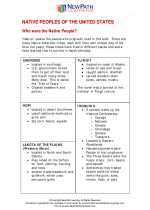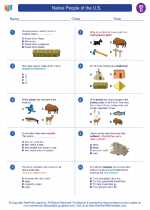Native People of the U.S.
In the United States, there are many different Native American tribes, each with its own unique traditions, languages, and cultures. These tribes have a long history in the country and have made significant contributions to American society.
Study Guide
- Origins: The Native American tribes are believed to have migrated to the Americas from Asia thousands of years ago. They were the first inhabitants of the land.
- Tribal Diversity: There are over 500 recognized tribes in the United States, each with its own distinct culture, language, and traditions.
- Traditional Lifestyle: Many Native American tribes traditionally lived in harmony with nature, relying on hunting, fishing, and agriculture for sustenance.
- Impact of European Arrival: The arrival of European settlers had a significant impact on Native American tribes, leading to conflicts, forced relocations, and loss of traditional lands.
- Resilience and Adaptation: Despite the challenges they faced, many Native American tribes have preserved their cultural heritage and traditions, and continue to contribute to American society.
- Modern Issues: Native American communities continue to face challenges such as poverty, health disparities, and preservation of their cultural identity.
Studying the history and culture of Native American tribes is important for understanding the rich diversity of the United States and the impact of colonization on indigenous communities.
.◂Social Studies Worksheets and Study Guides Fourth Grade. Native People of the U.S.
Study Guide Native People of the U.S.
Native People of the U.S.  Worksheet/Answer key
Worksheet/Answer key Native People of the U.S.
Native People of the U.S.  Worksheet/Answer key
Worksheet/Answer key Native People of the U.S.
Native People of the U.S.  Worksheet/Answer key
Worksheet/Answer key Native People of the U.S.
Native People of the U.S.  Worksheet/Answer key
Worksheet/Answer key Native People of the U.S.
Native People of the U.S. 

 Worksheet/Answer key
Worksheet/Answer key
 Worksheet/Answer key
Worksheet/Answer key
 Worksheet/Answer key
Worksheet/Answer key
 Worksheet/Answer key
Worksheet/Answer key

The resources above cover the following skills:
National Curriculum Standards for Social Studies (NCSS)
TIME, CONTINUITY, AND CHANGE
SOCIAL STUDIES PROGRAMS SHOULD INCLUDE EXPERIENCES THAT PROVIDE FOR THE STUDY OF THE PAST AND ITS LEGACY.
KNOWLEDGE - Learners will understand:
The study of the past is the story of communities, nations, and the world.
Key concepts such as: past, present, future, similarity, difference, and change.
Key people, events, and places associated with the history of the community, nation, and world.
Key symbols and traditions that are carried from the past into the present by diverse cultures in the United States and world.
That people view and interpret historical events differently because of the times in which they live, the experiences they have, and the point of view they hold.
That historical events occurred in times that differed from our own, but often have lasting consequences for the present and future.
National Center for History in Schools (NCHS)
Historical Thinking Standards
Chronological Thinking
Identify the temporal structure of a historical narrative or story.
Explain change and continuity over time.
Historical Comprehension
Identify the central question(s) the historical narrative addresses.
Historical Analysis and Interpretation
Formulate questions to focus their inquiry or analysis.
Challenge arguments of historical inevitability.
Historical Research Capabilities
Formulate historical questions.
Historical Issues-Analysis and Decision-Making
Identify problems and dilemmas in the past.
Topic 2: The History of Students' Own State or Region
The people, events, problems, and ideas that created the history of their state.
The student understands the history of indigenous peoples who first lived in his or her state or region.